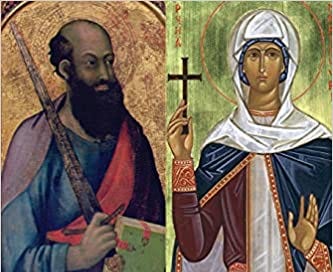Man and Woman, One in Christ: An Exegetical and Theological Study of Paul's Letters (Part 1)
by Philip B. Payne
Philip B. Payne‘s Man and Woman, One in Christ: An Exegetical and Theological Study of Paul’s Letters has been given the highest recommendation by Scot McKnight who says “this is the most technically proficient study ever published on women in the Pauline texts.” This is the first of ten posts on this important work.
The book is broken into multiple sections: chapters 1-3 are introductory, chapters 4-14 or Part 1 are grouped under “Exegesis of Paul’s Statements about Woman: Earlier Letters,” chapters 15-24 or Part 2 make up “Exegesis of Paul’s Statements about Woman: Latter Letters,” and a conclusion that asserts “Paul Consistently Champions the Equality of Man and Woman in Christ.” Published by Zondervan, the snyopsis reads:
Man and Woman, One in Christ demonstrates that careful exegesis of Paul’s letters affirms the full equality of men and women in the church and in the home. Exploring the entire Pauline corpus, Philip Barton Payne injects crucial insights and cultural backgrounds into the discussion of Paul’s statements regarding women.
I would like to offer some important insights from chapters 1-3 that I found especially enlightening.
From Chapter 1 “Backgrounds to Paul’s Teaching regarding Man and Woman”
After dismantling eleven arguments traditionally put forth from Genesis 1-3 to suggest “God put man in a position of authority over woman,” Payne offers twenty statements based on Gen 1-3 that show man and woman are equal:
God creates both male and female in God’s image and likeness (1:16-27; cf. 5:1-2).
God gives both male and female rule over animals and all the earth (1:26b, 28).
God gives both male and female the same blessing and tells them together to be fruitful and increase in number, fill the earth, and subdue it (1:28-29; cf. 5:2).
God speaks directly to both man and woman (1:28-29 “to them,” “to you” plural twice).
God gives male and female together all plants for food (1:29 “to you” plural).
Woman is a “help” to man, a noun the OT never elsewhere uses of a subordinate (2:18, 20).
Woman “corresponds to” man, literally “in front of” man, face-to-face, not below (2:18, 20).
God makes woman from the man’s rib, so she is made of the same substance as he (2:21-23).
The man recognizes, “This is now bone of my bones and flesh of my flesh” (2:23).
“Father and mother” are identified without hierarchical distinction (2:24).
A man is “united” to his wife, implying oneness (2:24).
A man becomes “one flesh” with his wife, implying unity (2:24).
Both the man and woman are naked and feel no shame, sharing moral sensibility (2:25).
The woman and the man are together at the temptation and fall (3:6); both faced temptation.
Both the woman and the man eat the forbidden fruit (3:6), both exercising a (bad) moral choice.
The eyes of both are opened, they realize they are naked, and sew coverings (3:7).
Both hide from God (3:8), showing they both experience guilt.
God addresses both directly (3:9-13, 16-19), showing both have access to God.
Both pass the blame (3:12-13), showing both have this weakness.
God announces to both specific consequences of their sin (3:16-19); both are responsible.
From Chapter 2 “Women Paul Names as Ministry Leaders”
Of the women mentioned, Phoebe especially caught my interests. Payne notes Phoebe’s leadership role is evident from “Paul’s request in Rom 16:2, ‘receive her in the Lord in a way worthy of the saints, and give her support in whatever matter she may have need from you, for she has been a leader [προστάτις, “leader, chief,” president or presiding officer,” “one who stands before,” …] of many and of myself as well.” Two things stood out to me: 1) “Since Paul includes himself as having been under Phoebe’s leadership, this was not simply a leadership role over other women.” 2) “Every meaning of every word in the NT related to the word Paul has chosen to describe Phoebe as a “leader” (προστάτις) that could apply in Rom 16:2 refers to leadership.” Of course, that Phoebe was a “διάκονον = servant” (Rom 16:1) does not necessarily mean she held the office of deacon, since Paul regularly calls himself a “servant.”
From Chapter 3 “Paul’s Theological Axioms Imply the Equality of Man and Woman”
Male and Female are Equally Created in God’s Image
Male and Female Equally Received the Creation Mandate and Blessing
The Redeemed–Male and Female–are Equally “in Christ”
The Nature of Church Leadership as Service Applies Equally to Male and Female
Mutual Submission in the Church Presupposes the Equal Standing of Women and Men
Mutual Submission in Marriage Presupposes the Equality of Men and Women
The Oneness of the Body of Christ Presupposes the Equality of Men and Women
The Priesthood of All Believers Presupposes the Equality of Men and Women
The Gifts of the Spirit Manifest the Equality of Men and Women
Liberty in Christ Presupposes the Equality of Men and Women
Inaugurated Eschatology Requires the Equality of Men and Women While Affirming that the Sexes Complement Each Other
In Christ, Male and Female Are Equal
More insights from this important work will be posted in subsequent parts.
Share (please & thank you)




